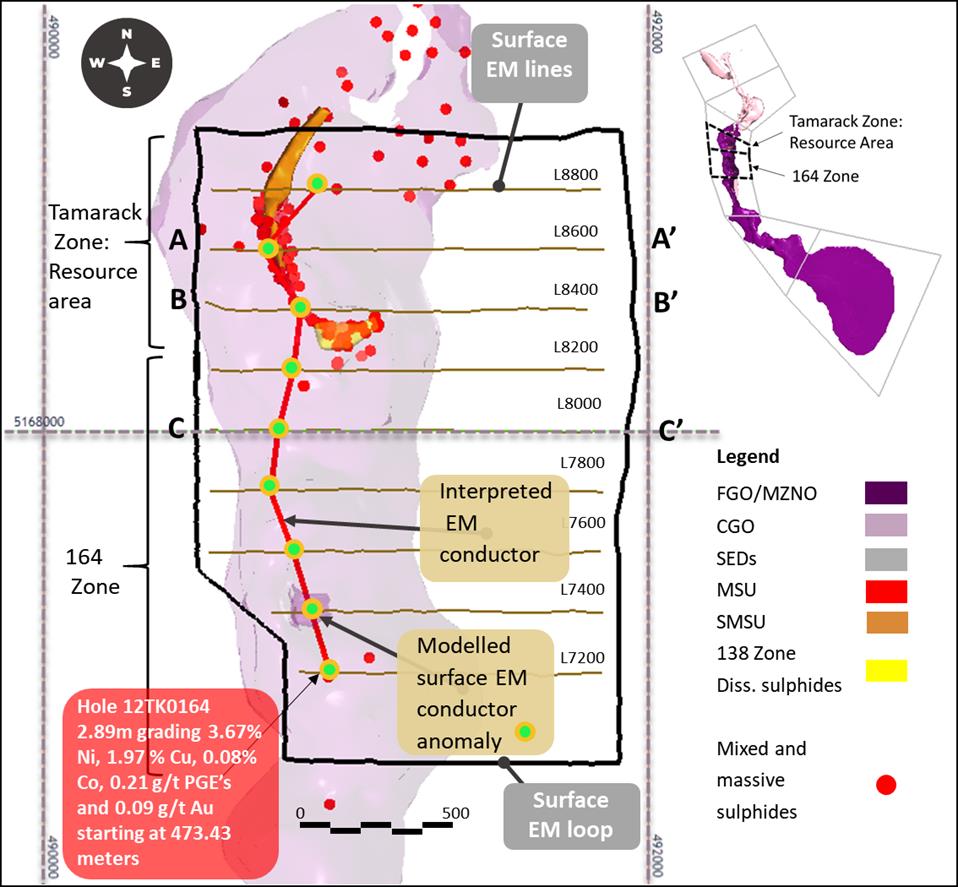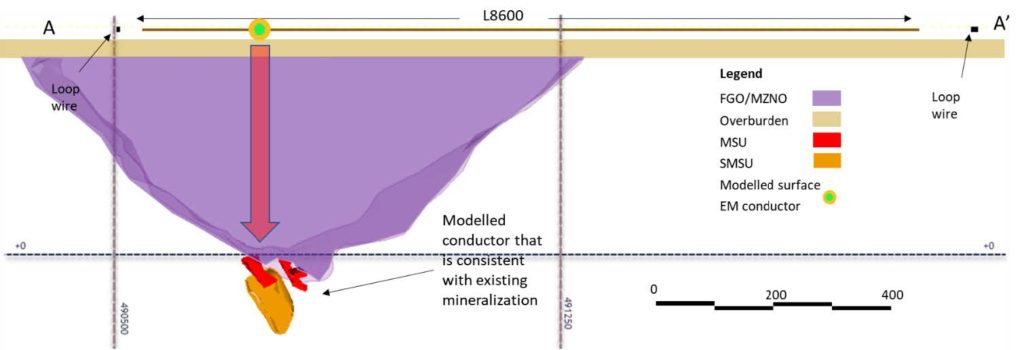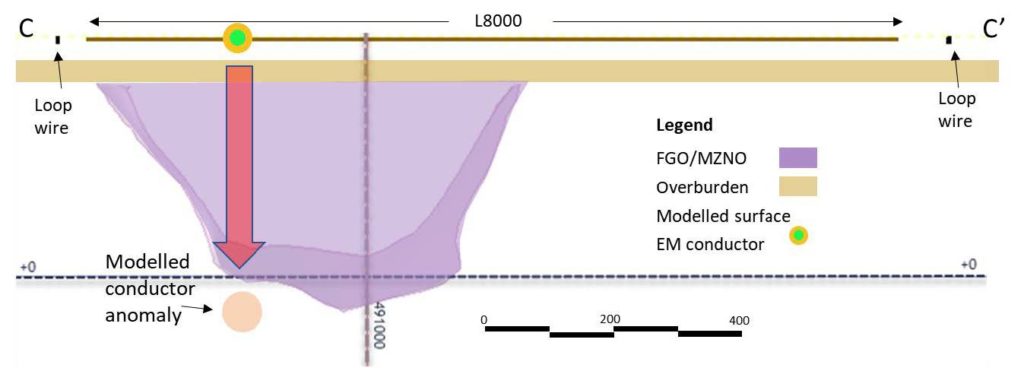MEDIA ADVISORY
News Release
TSX:TLO
TALON METALS IDENTIFIES 1 KM LONG GEOPHYSICAL ANOMALY AND CONFIRMS POTENTIAL FOR MAKING A NEW DISCOVERY AT TAMARACK
Road Town, Tortola, British Virgin Islands (May 26, 2020) – Talon Metals Corp. (“Talon” or the “Company”) (TSX:TLO) is pleased to announce the discovery of new geophysical anomalies that highlight the potential for a 1 km extension of nickel-copper sulphide mineralization at the Tamarack Nickel-Copper-Cobalt project (“Tamarack Project”), located in Minnesota, USA. The Tamarack Project comprises the Tamarack North Project and the Tamarack South Project.
Summary
- As part of the Company’s Winter 2020 Exploration Program, the Company completed a Surface Electro-Magnetic (“Surface EM”) geophysical survey over (i) the Company’s existing resource area as a control survey; and (ii) an area extending 1 km south of the Company’s resource area to identify new exploration
- Within the existing resource area, the Surface EM confirmed a long linear target at a depth of 400 meters to 500 meters, which corresponds with the depth of the existing high-grade mineralization.
- The Surface EM survey south of the Company’s resource area identified a continuous string of anomalies along a 1 km path at a depth that is consistent with mineralization found in the Company’s resource area (Figure 1 – L8200, L8000, L7800, L7600 and L7400).
- These Surface EM anomalies connect the resource area’s massive sulphides to other massive sulphides previously discovered 1 km to the south of the resource area. This indicates that larger connected resources may exist within this region of limited
“We have always hoped that Surface EM would be able to help identify mineralization at the Tamarack Project,” said Brian Bengert, Talon’s Geophysicist. “Historically, this project area has been hamstrung by near surface conductive features that have shielded the targets below. Using the combined knowledge gained over the years on this project, we created a low-frequency, large loop survey design, and novel time series processing methods that allowed us to penetrate these shielding conductors and identify the EM signatures of the Tamarack sulphides at depth. This robust methodology could prove to be a very cost-effective way to make new discoveries along the 18-kilometer Tamarack Intrusive Complex. As part of the next program, we plan to expand the Surface EM survey north of the resource area, where other high-grade nickel (e.g., 9.95% Ni) has already been intercepted. The success of Surface EM at the Tamarack Project is an exciting development, and the Company will make it a high priority to test these targets during its next drill program.”
Henri van Rooyen, CEO of Talon, continued: “The geophysical survey results of the winter 2020 exploration program could be the turning point for exploration at the 18-km Tamarack Intrusive Complex: we have tested a suite of geophysical techniques that we used to model an exploration target that coincides with the approximate location of the high-grade massive sulphide unit in our resource area. It therefore follows that we can now cost-effectively and rapidly expand our search radius to explore areas in the vicinity of similar high-grade nickel intercepts with the goal of discovering entirely new massive sulphide bodies. This is what we are gearing up for.”
Technical Discussion – Surface EM
In December, the Company completed a Surface EM survey over the Tamarack Zone (resource area) and 164 Zone (the area 1 km south of the Company’s resource area). A large 1400 meter by 2000 meter fixed loop was laid out and data was collected on east-west lines with a 200 meter line spacing and stations located every 50 meters. The objective was to calibrate the survey to the known mineralization within the Company’s resource area (Tamarack Zone) and identify if similar conductors exist further south.
The data from this Surface EM survey delineates a long linear conductive anomaly extending from the Tamarack Zone (resource area) to the massive sulphide intercepts within the 164 Zone (1 km south of the resource area) (Figure 1). This fits the electro-magnetic signature of the conductor that corresponds to the high-grade massive sulphide unit observed within the known resource area.

Figure 1: Plan view map of the Tamarack Zone (resource area) and 164 Zone (1 km south of the resource area) showing the location of the Surface EM survey. The solid red line shows the location of the interpreted conductive anomalies.
Figures 2 and 3 show a conductor below the FGO/MZNO footwall contact in the surface electro- magnetic profiles of lines L8600 (A-A’) and L8400 (B-B’) within the Tamarack Zone (resource area). Of note, Figure 4 also shows a similar conductor below the FGO/MZNO footwall contact in the surface electro-magnetic profiles of line L8000 (C-C’) located within the 164 Zone (1 km south of the resource area).

Figure 2: Cross-section looking north at line L8600 (A-A’) located over the high-grade Massive Sulphide Unit (MSU) and Semi-Massive Sulphide unit (SMSU) mineralization within the Tamarack Zone (resource area). The Surface EM anomaly corresponds to the conductive mineralization at depth (with the conductor being at an approximate depth of 320 meters). Refer to Figure 1 for location of L8600.

Figure 3: Cross-section looking north at line L8400 (B-B’) located over the high-grade Massive Sulphide Unit (MSU) mineralization within the Tamarack Zone. The Surface EM anomaly corresponds to the mineralization at depth (with the conductor being at an approximate depth of 500 meters). Refer to Figure 1 for location of L8400.
Based upon historical drilling, the 164 Zone (1 km south of the resource area) and the Tamarack Zone (resource area) appear to share the same geology, and now show a similar conductor at a depth of 450 meters (Figure 4), just meters below the interpreted FGO footwall contact. In addition, this Surface EM anomaly connects the resource area’s sulphide mineralization to the mixed and massive sulphides previously intercepted approximately 1 km south of the Company’s resource area, where limited drilling has been conducted (see Figure 1).
 Figure 4: Cross-section looking north at line L8000 in the 164 Zone (1 km south of the resource area) showing the location of the conductor with respect to the Surface EM anomaly (with the conductor being at an approximate depth of 425 meters). Refer to Figure 1 for location of line L8000.
Figure 4: Cross-section looking north at line L8000 in the 164 Zone (1 km south of the resource area) showing the location of the conductor with respect to the Surface EM anomaly (with the conductor being at an approximate depth of 425 meters). Refer to Figure 1 for location of line L8000.
Quality Assurance, Quality Control and Qualified Persons
Please see the technical report entitled “NI 43-101 Technical Report Updated Preliminary Economic Assessment (PEA) of the Tamarack North Project – Tamarack, Minnesota” with an effective date of March 12, 2020 prepared by independent “Qualified Persons” (as that term is defined in National Instrument 43-101 (“NI 43-101”) Leslie Correia (Pr. Eng), Andre-Francois Gravel (P. Eng.), Tim Fletcher (P. Eng.), Daniel Gagnon (P. Eng.), David Ritchie (P. Eng.), Oliver Peters (P. Eng.), Christine Pint (P.G.) and Brian Thomas (P. Geo.) for information on the QA/QC, analytical and testing procedures at the Tamarack Project. Copies are available on the Company’s website (www.talonmetals.com) or on SEDAR at (www.sedar.com). The laboratory used is ALS Minerals who is independent of the Company.
Lengths are drill intersections and not necessarily true widths. True widths cannot be consistently calculated for comparison purposes between holes because of the irregular shapes of the mineralized zones. Drill intersections have been independently selected by Talon. Drill composites have been independently calculated by Talon. The geological interpretations in this news release are solely those of the Company.
The locations and distances highlighted on all maps in this news release are approximate.
Dr. Etienne Dinel, Vice President, Geology of Talon, is a Qualified Person within the meaning of NI 43-101. Dr. Dinel is satisfied that all of the geophysical data collection, processing, analysis and interpretation were completed using standard industry operating procedures and methodologies. Dr. Dinel has reviewed, approved and verified all of the technical information disclosed in this news release.
About Talon
Talon is a TSX-listed base metals company in a joint venture with Rio Tinto on the high-grade Tamarack Nickel-Copper-Cobalt Project located in Minnesota, USA, comprised of the Tamarack North Project and the Tamarack South Project. Talon has an earn-in right to acquire up to 60% of the Tamarack Project. The Tamarack Project comprises a large land position (18km of strike length) with numerous high-grade intercepts outside of the current resource area. Talon is focussed on expanding its current high-grade nickel mineralization resource prepared in accordance with NI 43-101; identifying additional high-grade nickel mineralization; and developing a process to potentially produce nickel sulphates responsibly for batteries for the electric vehicles industry. Talon has a well-qualified mine management team with extensive experience in project management.
For additional information on Talon, please visit the Company’s website at www.talonmetals.com or contact:
Sean Werger
President
Talon Metals Corp.
Tel: (416) 361-9636 x102
Email: werger@talonmetals.com
Forward-Looking Statements
This news release contains certain “forward-looking statements”. All statements, other than statements of historical fact that address activities, events or developments that the Company believes, expects or anticipates will or may occur in the future are forward-looking statements. These forward-looking statements reflect the current expectations or beliefs of the Company based on information currently available to the Company. Such forward-looking statements include statements relating to the potential for a new discovery at Tamarack, including a 1 km extension of nickel-copper sulphide mineralization at the Tamarack Project, the potential that larger connected resources may exist within the region of limited drilling 1km to the south of the resource area, the ability to identify the EM signatures of the Tamarack sulphides from surface which could prove to be a very cost-effective way to make new discoveries at Tamarack and future exploration plans and drill targets. Forward-looking statements are subject to significant risks and uncertainties and other factors that could cause the actual results to differ materially from those discussed in the forward-looking statements, and even if such actual results are realized or substantially realized, there can be no assurance that they will have the expected consequences to, or effects on the Company.
Any forward-looking statement speaks only as of the date on which it is made and, except as may be required by applicable securities laws, the Company disclaims any intent or obligation to update any forward-looking statement, whether as a result of new information, future events or results or otherwise. Although the Company believes that the assumptions inherent in the forward- looking statements are reasonable, forward-looking statements are not guarantees of future performance and accordingly undue reliance should not be put on such statements due to the inherent uncertainty therein.
